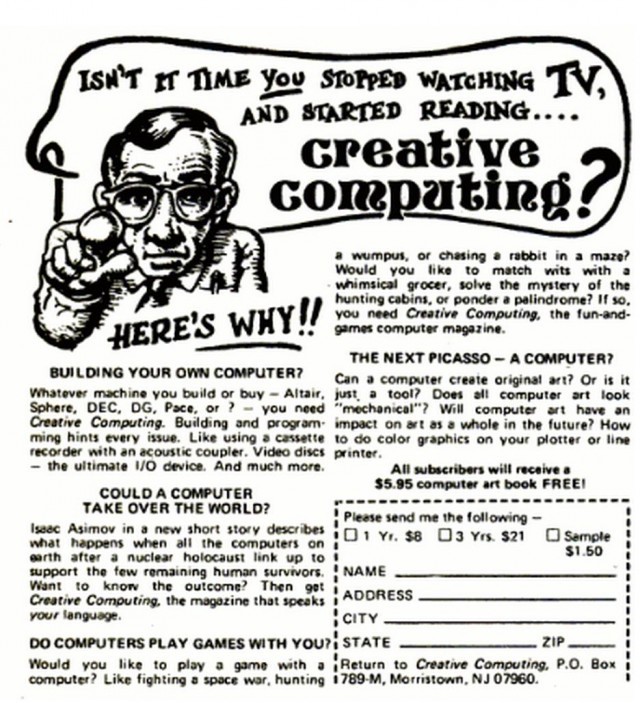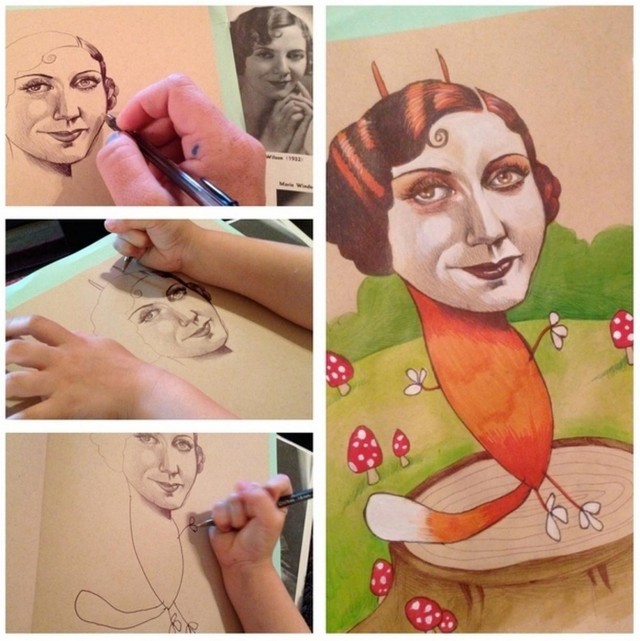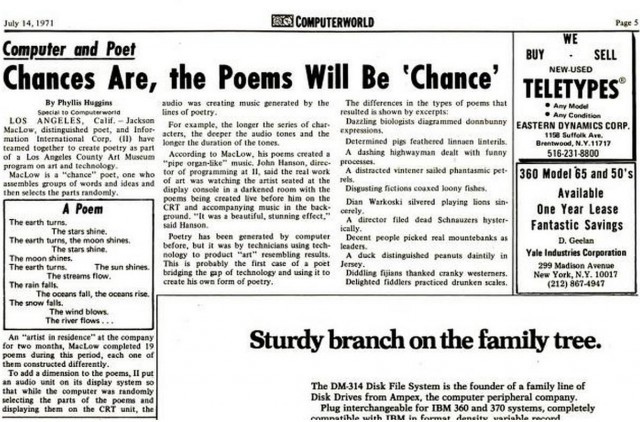Robopoetics: The Complete Operator's Manual
by Johannah King-Slutzky
Here’s a game: which of these poems was written by a human, and which by a computer?
A wounded deer leaps highest,
I’ve heard the daffodil
I’ve heard the flag to-day
I’ve heard the hunter tell;
’Tis but the ecstasy of death,
And then the brake is almost done,
And sunrise grows so near
sunrise grows so near
That we can touch the despair and
frenzied hope of all the ages.
vs.
Red flags the reason for pretty flags.
And ribbons.
Ribbons of flags
And wearing material
Reason for wearing material.
Give pleasure.
Can you give me the regions.
The regions and the land.
The regions and wheels.
All wheels are perfect.
Enthusiasm.
Answer: the first one is a computer, the second one is Gertrude Stein. You can find both of these poems on the website Bot or Not, “a Turing Test for poetry” created by Oscar Schwartz and Benjamin Laird. Bot or Not premiered for the recent Digital Writers’ Festival, and it is fun. It turns the romantic notion of creativity as “collected lightning” on its head — French-Romanian avant-garde poet Tristan Tzara really does sound like a robot, and so does contemporary poet Deanna Ferguson. So does Gerard Manley Hopkins. If some of the best modern and contemporary poets sound like robots, the reverse is true, too: many computer-generated poems are a détournement of human poetics. For example, that computer-generated poem you just read was programmed by Ray Kurzweil based on Emily Dickinson.
Behind the scenes, Robopoetics varies greatly with programming and word bank. This is a piece of code for HaikuFinder, the Python used by The New York Times Haiku generator. (It’s actually a Ruby port of a Python haiku finder.) It’s open source, so if you know something about computers, you too can feel free to download and tinker.
text = open(“ulysses.txt”, “r”).read()
haikus = HaikuFinder(text).find_haikus()
for haiku in haikus:
print haiku[0]
print “ %s” % haiku[1]
print haiku[2]
print
Jonathan Feinberg, HaikuFinder’s programmer, describes the tool as a “hack” that identifies Haiku-able structures in everyday English prose:
Each canididate [sic] haiku line, and then the entire haiku, has to make it through a few heuristics to filter out constructions that are likely to scan awkwardly (like verb phrases split across lines). Since this code doesn’t really try to understand the texts, it might throw away a few legitimate phrases, and it certainly lets through some bad ones.
Here’s another completely different computer-generated poem, programmed by Aaron Uhrmacher and a co-worker (“Chris”) using Python script and YouTube captioning. Uhrmacher describes their methods as follows:
Our Python script generated these poems automatically by analyzing the subtitles of 50 YouTube videos based on the keywords that we provided. When it found the word or phrase, it returned the line in the closed captioning from where it was found.
In this case, the YouTube keyword was “I need”:
I NEED
I need you to survive.
And I’m like, “Oh UGH! Why did I need coffee now?”
That way to I can actually go
ahead and carve out that area that I need.
Since I need this to kind of come up in an angle
I’m going to start at an angle.
I’m fall and then I’m going to see where I need
to adjust my line. I’m not going to use any.
I realized I had a lot of very difficult memories
that I need to let go of.
Is what I need to do right now while listening
to good music. You don’t even wanna see.
I love you, I need you, yeah.
I love you, I need you, oh, babe.
And I need you like a heart needs a beat.
That’s why I need to search for you.
I need a new car.
Charles Please marry me, Fiona.
I want you, I need you, I love you.
I need you.
I’ll lend an ear.
To find out what I need to repair.
Although computer-generated poetry may feel abrasively modern, the idea of computer-generated poetry is at least as old as Jonathan Swift. Gulliver’s Travels, published in 1726, features a wired and wooden block that mechanically cranks out “books in philosophy, poetry, politics, laws, mathematics, and theology, without the least assistance from genius or study.” When I emailed Bot or Not creator Oscar Schwartz, he intimated that robopoetics is even older than Swift: if you ablate the trend pieces, you’ll find an ancestral Robopoetics in Virgil’s accounts of the Cumaen Sybil, who practiced cut-up poetry by writing on oak leaves that could be scried through rearrangement. In Eros the Bittersweet, Anne Carson — with an assist from Socrates — even goes as far as to argue that all writing is recombinatory.

“The next Picasso — a computer?” From Computerworld, Dec. 3, 1975
A less picaresque version of this thesis is that computer-generated poetry, far from native to the new genre of e-lit, is just a faster-composed iteration of experimental literature. The commonest way computers write poetry is by reproducing pre-defined syntax, grammar, and diction with selections from a word bank. This is how Claude Shannon — Wikipedia bills him as “the father of information theory” — wrote the first computer-generated texts by hand in 1949. (The fact that you can write a computer-generated text by hand should give you an idea of how mutable these categories are.) Here’s an account of Shannon’s process, from Margaret A. Boden’s Mind and Machine:
Taking a book from his bookshelves, he opened it at random, and wrote down a word selected randomly from the open page. Next, he opened the book at another randomly chosen page, and read on until he encountered the previously recorded word. At that point, he wrote down the immediately following word. Then, he repeated the process again and again, always using the most recently recorded word as his guide.
Here is the text the Shan-puter generated:
The head and in frontal attack on an English writer that the character of his point is therefore another method for the letter than the time of who ever told the problem for an unexpected.
This computer-ish text — algorithmic, if not totally faithful to the humanless ideal — is explicitly inscribed in the early AI tradition, if only because Shannon was its programmer. But compare that to the Surrealists’ exquisite corpse, which has since been absorbed into AI canon, but which André Breton invoked as theurgy. (Even if you don’t already know what it is, you’ve probably played exquisite corpse without realizing it. Here are the rules as explained by Wikipedia: “Each collaborator adds to a composition in sequence, either by following a rule (e.g. ‘The adjective noun adverb verb the adjective noun,’ as in ‘The green duck sweetly sang the dreadful dirge’) or by being allowed to see only the end of what the previous person contributed.”)
This is an aporium theorists still attempt to puncture: computers, devoid of emotion, are hyper-rational. But they use the same technologies Breton called a way of “opening certain doors that rationalist thought flattered itself it had condemned for good.”

This image, which made the rounds on the internet last fall, is an exquisite corpse in drawing form. via.
Brion Gysin and William S. Burroughs picked up a similar Surrealist technique when they discovered cut-ups. The original Gysin cut-ups involved slicing newspaper into strips with a razor and patching them together at random. Nowadays you can do this virtually by computer, too. Like Breton and Virgil, Burroughs believed his proto-computer technology was mystical: “When you cut into the present the future leaks out.”
WHEN YOU LOOK BACK AND EVERYTHING IS DIFFERENT.

Not strictly poetry, but here’s a similar idea in computer-generated form, from Adam Parrish’s Gif and Circumstance. (“Gifs juxtapose randomly and automatically with tweets containing the word ‘when.’”)
I don’t know of any proto- or contemporary RP that is not recombinatory, but it’s not all slice-and-dice, either. Jackson Mac Low wrote this poem in 1960 using Moby Dick’s “C-A-L-L-M-E-I-S-H-M-A-E-L” as an acrostic (or, more precisely, “diastic”) string. Read the poem; you’ll see the first line, “Circulation. And long long” corresponds to C-A-L-L and goes on from there. The precise diction was selected through the I-Ching:
Circulation. And long long
Mind every
Interest Some how mind and every long
Coffin about little little
Money especially
I shore, having money about especially little
Cato a little little
Me extreme
I sail have me an extreme little
Cherish and left, left,
Myself extremest
It see hypos myself and extremest left,
City a land. Land.
Mouth; east,
Is spleen, hand, mouth; an east, land.

Coverage of Jackson Mac Low in a 1971 edition of Computerworld.
Acrostics-permutations like Mac Low’s can be modified to suit the author’s ideal volume of chance. In her study of John Cage’s mesostics (that is, acrostics but with the key words in the middle of a line), Marjorie Perloff makes a convincing case for Cage’s artistry despite the many anomalies native to a tool like mesostics:
When Cage began to write mesostics, he adopted Mac Low’s acrostic procedures, but with an important difference. Whereas in the example above, Mac Low lets chance operations generate the entire text, Cage, as we shall see, uses these operations to generate the word pool to be used and the rules to be followed, but he then fills in lines with “wing words,” generated, as he repeatedly put it, “according to taste.”…Indeed, however visually striking Cage’s verbal scores may be, the mesostic column creat[ed] an interesting pattern and the punctuation marks of the original [were] often strewn around the page.
So for example, if you look at a segment from Cage’s Jasper Johns-based mesostic “What you say…,” you’ll find Cage playing in decidedly non-random ways with sound, repetition, and meaning:
to bE
my tendenCy
That
spaCe
2) doeS one
fUnction as a
tenDency
3) mY tendency
is correct
4) it intErests me
tenDency
it
5) anD perhaps
whaT one takes to be
tendency to add tHings is
havE
6) caN
One
Tendency to
sometHing
Still cribbing from Perloff:
This is Cage at his most Steinian, charging language by means of permutation, words like “tendency” taking on a different aura with every repetition….[T]he spacing and mesostic chain produces its own meanings, so that “tenDency,” with that “ten” separating out, is not the same as “tendenCy,”….Cage is always constructing new meanings, in this case giving new connotations to a “tendency” [Jasper] Johns mentions only casually….For given the nature of the writing-through process, there are only so many words at the composer’s disposal, and these words — “what,” “world,” “perhaps,” “another,” “something,” “interest,” “function” — appear again and again, becoming familiar counters.
The point being: algorithms can be manipulated to include human originality and vision.
Even true robopoetics — poems generated by programmable, non-native language — demand human input. For one thing, it’s humans who devise the algorithms and Javascript (or whatever) which animate these botty-pasticheurs. Kenneth Goldsmith, who just wrote a book in praise of “uncreative writing,” is in favor of a little human discretion: “Success lies in knowing what to include — and, more important — what to leave out…. [T]he moment we throw judgement and quality out the window we’re in for trouble. Democracy is fine for YouTube, but it’s generally a recipe for disaster when it comes to art.”
If you are unfamiliar with Goldsmith, check him out on C.S. Roy and Mark Slutsky’s upcoming documentary, Noriginals. This is not a man who sings the praises of human invention.
On a more granular level, computers obviously interact with humans and affect their behavior. As Ryan Wallach points out in The Hypocrite Reader, the fact that we’ve internalized “the world wide web” as some kind of IRL synecdoche is proof positive that computer and human cognitive maps are mixing. There is even a school of electronic literature called “code work,” which Katherine Hayles identifies as a blending of natural and programming languages. That’s what’s going on in the human-generated poetry of Mez, who writes sentences like:
Exe.cut[up]able statements — -
::do knot a p.arse.r .make.
::reti.cu[t]la[ss]te. yr. text.je[llied]wells .awe. .r[b]ust.
When I asked Bot or Not’s Oscar Schwartz how computer-generated poetry affected his own artistic output, he reminded me that “when a human is executing an algorithm, they make mistakes, and deviate from the instructions. When computers execute an algorithm, they do it flawlessly.” This distinction is comforting. Nevertheless, the theorist-artists Johanna Drucker and Geoffrey Rockwell have used errors in OCR transcription as a source of both pun and plot in their e-lit narrative/game Ivanhoe, a collaborative choose-your-own-adventure revision of Turn of the Screw. Clearly, computers can make mistakes, and those mistakes are empirically artistically useful.
Is anything about computer-generated poetry radically new? Mostly, yes. Robopoetics challenge several conventional theories about literature and bolster other claims (like Barthes’ death of the author) with hard, non-theoretical proof. In electronic literature there is no dyadic author and text: the new creative schema is a triad of programmer, robotic author, and text. Robopoetics shifts the burden of creativity onto programming and the selection of source materials. (If you’re feeling contrarian you might argue that this contemporary triad isn’t so different from the classical muse-author-text model, but anyway.)
RP also challenges the distinction between criticism and creation. In the 60s and 70s, scientists programmed machines to analyze patterns in grammar, syntax, and diction. Some human oversight was required: computers identified patterns and humans culled from the most notable. But identifying these strings of text is how computers generate poetry in the first place. For example, a computer might find that Maurice Sendak is most likely to follow “I don’t” with “care,” while Nabokov is most likely to follow “I don’t” with “know.” A text generator would employ this information to generate a Nobokovian or Sendakian poem. Human poets learn to write via analysis and imitation, too, but AI isolates the habit.
And there is a stronger case for the uniqueness of computers’ creation-interpretation hybrid. In his essay on robopoetics, Ryan Wallach reminds us that computers would cease to function without this conflation: in executing a program, computers literally cannot read a 1 or a 0 without acting as told.
In the wake of robopoetics, humans might re-focus their literary criticisms to accommodate inexhaustible and ego-free texts, as well. For example, Loss Pequeño Glazier’s 1999 poem “White-Faced Bromeliads on 20 Hectares” is a kind of computerized cut-up that would take lifetimes to read in its entirety. Theorists of electronic literature have proposed that we criticize e-lit by reading the (finite) code, not the (near infinite) text; or by talking about affect and experience instead of meaning. Collectively, these new paradigms have the potential to be big. If Shakespeare gave us humanist subjectivity, electronic literature could give us hiveminds.

Screencap of one of many possible first pages for White-Faced Bromeliads.
Realistically there are only a handful of people who study both human- and computer-generated poetry, and Oscar Schwartz is one of them. He says that poring over computer-generated poetry has actually excited him to pay more attention to phenomena like intention and communication, when applicable: “[S]ome language poets write that poetry is just the art of language. If this is the case, then we can just sit back at watch [the] computer as it combines all possible variations of words. So why don’t [I] want to do that? I think it’s because poetry is actually the art of communication. If you look at computer poetry for a long time, and I have, that’s what you realise. If you know that a poem was written by a computer, it somehow feels like it communicates in a different way. It has a different meaning…. Since I have started looking into computer poetry, I have become most interested in writing poems that try to express my human experiences.”
I got pretty good at Bot or Not, and one of the ways I did so was by identifying insight. Insight makes for a sloppy rubric, but that’s how I inferred that this poem was made by a human,
Illegibility of this
World. All twice-over.
Robust Clocks
agree the Cracked-Hour,
hoarsely.
You, clamped in your Depths,
climb out of yourself
for ever.
…but this poem:
Big, small seashells quietly fight a lively, sunny tuna.
Never command a sailor.
The captain travels like a misty seashell.
All whales view rough, clear waves.
was not.
I’ve written and read more than the average amount of poetry, but somehow amidst all the difficult poetry, I forgot that relatability and straightforwardness are the marks of a mature poet, too. Once, I read computer-generated poetry for 10 hours straight. The next week I could only stomach plainspoken Du Fu. I had to turn the clock back 1200 years. In this and other ways, games like Bot or Not might be a good learning tool. The same skill you refine by playing Bot or Not — the detection of gibberish — can also assist in separating the livejournal from the laureate. Compare befuddled poetry program Gnoetry to the obscurantism of an amateur poet and you’ll see what I mean.
Computer-generated poetry can be insightful, but that horizon is far off without the aid of some kind of conceptual framework, like that of (I’m making this up) a U.S. Constitution mesostics machine that spells out S-C-R-E-W-Y-O-U. Likewise, humans can produce sweeping choose-your-own-adventure poems, but they’re rarely as arbitrary and flooding as a computer-generated poem like White-Faced Bromeliads. Learning to detect the difference between these two mingled kinds of poetry could be the legacy of early robopoetics and games like Bot or Not. In the words of Bot or Not’s creator, “The ability to tell whether something is of human or computer provenance… might become really important. We will all be like blade runner people, trying to tell if a text is human.”
In a universe where robopoets are only a Horse_e click away, human poets may find lucidity and ego exert a stronger tug than they once did. For example, in Leaving the Atocha Station, IRL poet Ben Lerner’s semi-fictive avatar describes the way he puts together poems by prioritizing sound and diction over meaning:
On these days I worked on what I called translation. I opened the Lorca more or less at random, transcribed the English recto onto a page of my first notebook, and began to make changes, replacing a word with whatever word I first associated with it and/or scrambling the order of the lines, and then I made whatever changes these changes suggested to me. Or I looked up the Spanish word for the English word I wanted to replace, and then replaced that word with an English word that approximated its sound (“Under the arc of the sky” became “Under the arc of the cielo,” which became “Under the arc of the cello”). I then braided fragments of the prose I kept in my second notebook with the translations I had thus produced.
This is a completely respectable practice used by many excellent, mature poets. But later in the novel, the young poet (Adam Gordon) is converted:
If I was a poet, I had become one because poetry, more intensely than any other practice, could not evade its anachronism and marginality and so constituted a kind of acknowledgement of my own preposterousness, admitting my bad faith in good faith, so to speak….I had been a small-time performance artist pretending to be a poet, but now, with an alarming fervor, I wanted to write great poems. I wanted my “work” to take on the United States of Bush, to shed its scare quotes…
Can great poetry be aped by OCR hiccups and solecisms in Google Translate? In any case, if the narrator is to be believed, mondegreen and “scrambling the order of the lines” no longer feel to him like great poetry. Adam wants unqualified work, not a Swiftian engine of “poetry… without the least assistance from genius or study.”
Perhaps relatedly, Adam’s extant author Ben Lerner continues to write mistranslated, algorithm-inflected poems, but he’s also begun to write semi-autobiographical novels, and has spoken publicly about a trend in the avant-garde to merge art with IRL. My thinking here is self-evidently nascent, but I suspect it’s not insignificant that Lerner’s behind-the-scenes interviews discuss “the virtual” and “the actual,” which are both terms employed by RP theorists, although in Lerner’s case he’s referring to the work of e-lit-unaffiliated critic Allen Grossman. Grossman develops “the virtual” and “the actual” in an investigation of the suicide of Hart Crane, who wished to become numinous. Maybe the answer to Adam Gordon’s “great poems” rests with whether or not you believe transcendence can be a computer.
Johannah King-Slutzky is not a robot. She tweets @jjjjjjjjohannah.
